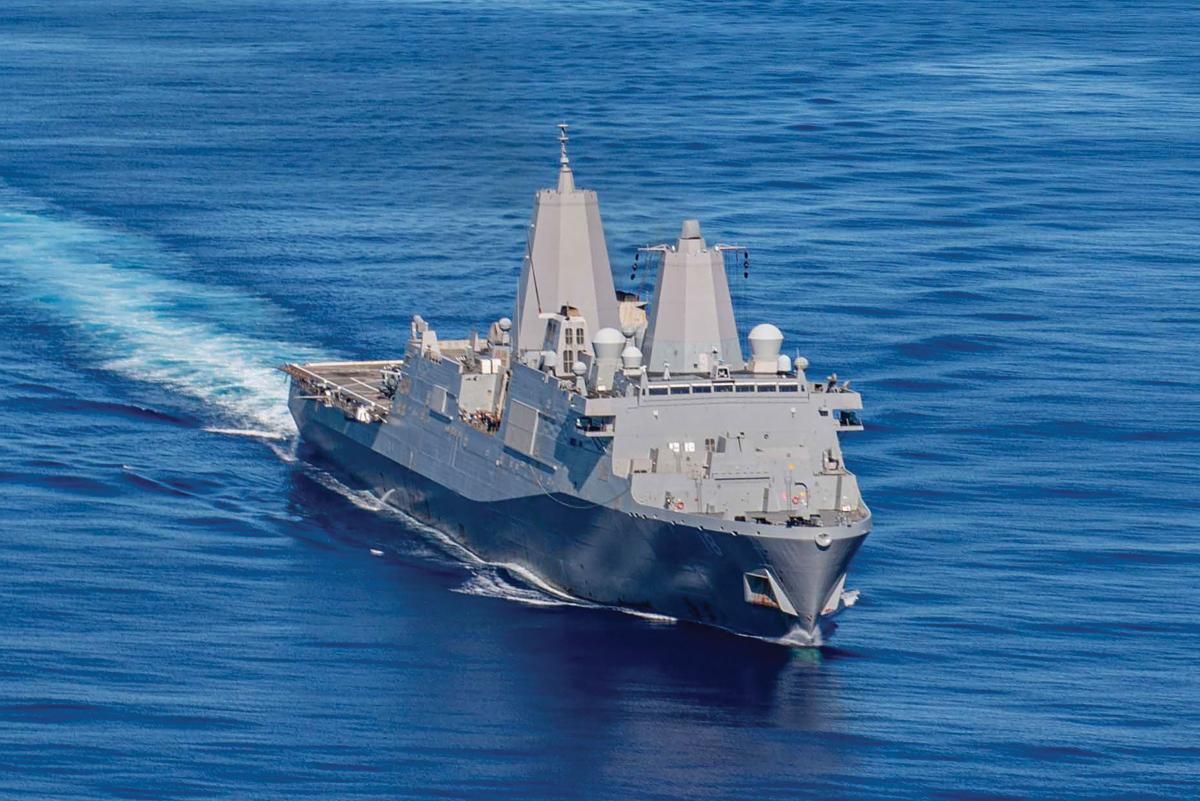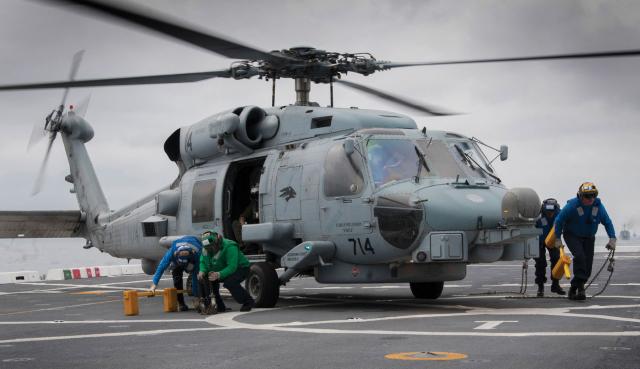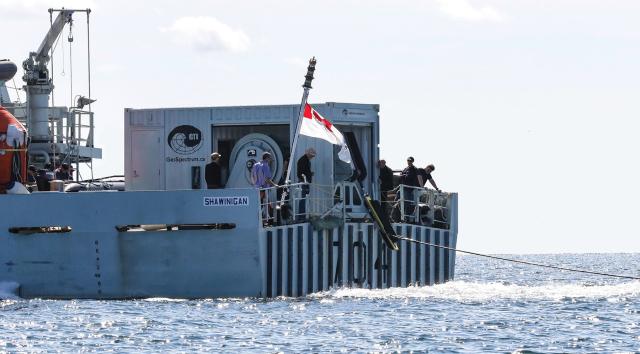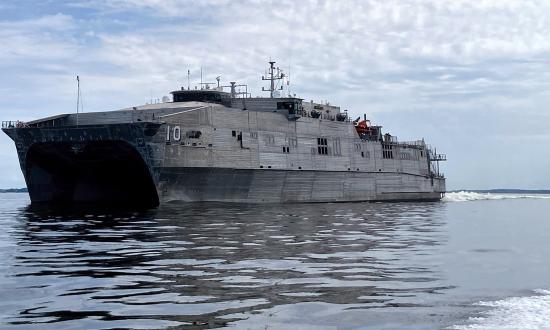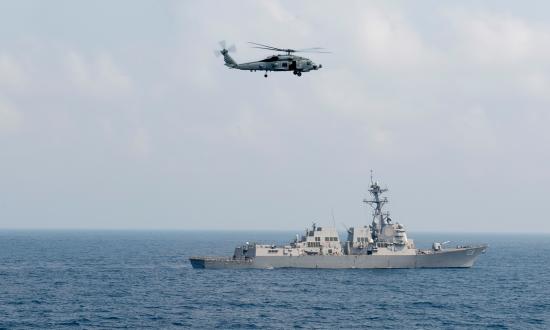During World War II, the U.S. Navy formed specialized task groups to combat the German U-boat threat to allied shipping. Composed of destroyers, destroyer escorts, and escort or auxiliary aircraft carriers to provide command and control and organic antisubmarine aircraft, they were known as hunter-killer groups. Today, the Navy is facing a technologically complex, highly lethal, and growing submarine and surface threat from both Russia and China. To counter this threat and complicate Russian and Chinese strategies, the Navy should resurrect the concept of a dedicated antisubmarine task group composed of guided-missile destroyers (DDGs), littoral combat ships (LCSs), guided-missile frigates (FFGs) when available, and allied and partner-nation ships, anchored by a San Antonio–class amphibious transport dock (LPD) to provide command and control and ASW aircraft.
This new 21st-century hunter-killer group (HUK21) could operate in direct support to carrier strike groups or independently.
A New Construct
Under the current antisubmarine warfare (ASW) or sea combat commander construct, the destroyer squadron (DesRon) commander is embarked on board the strike group aircraft carrier. To manage the DesRon’s duties and responsibilities, the commander embarks a staff of approximately 35 personnel. Berthing space, planning space, communication circuits, and staff size are limited, as the DesRon must share these resources with the strike group commander’s staff and the air wing staff.
Among warfare commanders in a strike group, there is always competition and conflicting priorities regarding resources. Everything the DesRon commander does to execute his duties is in concert with the competing warfare commanders’ and the strike group commander’s interests, assets, and priorities. The consequence of this tight coordination and battle for resources can result in the DesRon commander having to compromise his or her effectiveness as the ASW or sea combat commander.
Often the ships of the DesRon are so geographically dispersed that command and control becomes difficult or cumbersome, and the commander must delegate authority and missions to local unit commanders.1 This was demonstrated during Trident Juncture 2018, when the North Atlantic/Norwegian Sea operating environment, combined with operating with NATO allies, presented command-and-control challenges.2 Local authority is required to execute tactical operations in a timely and efficient manner. Having command and control located close to the point of execution is essential, especially in a communications-denied or -degraded environment.
Under the HUK21 concept, the task group would not be a new permanent formation; rather, it would be stood up when fleet operations and the threat environment dictate. For example, it could be stood up to support a numbered fleet commander’s requirement to cover a geographic area such as the eastern Mediterranean and South China Sea for a period of time, or in direct support of and inside the composite warfare commander construct of a carrier strike group operating in a high-threat ASW area. A HUK21 task group would be scalable in ships, aircraft, and payloads, based on the threat.
The HUK21 concept has multiple advantages. It does not involve building a new ship, does not unnecessarily hazard the aircraft carrier, frees the carrier’s valuable flight deck space for more strike aircraft, augments the battle force with greater capacity and flexibility, and complicates any potential adversary’s planning and targeting.
The Right Platform for the Job
When operating as part of HUK21, the LPD’s “payload” would simply change from an embarked Marine expeditionary unit to an embarked DesRon and aircraft detachment, without changing the platform. The LPD has the necessary command-and-control infrastructure, intelligence-gathering capability, planning spaces to direct the fight, and aircraft capacity to hunt down and prosecute submarines. With its large flight deck and hangar and the ability to operate large numbers of helicopters and unmanned air vehicles, it is an incredibly capable, multimission ship with untapped potential to contribute to the fleet’s lethality.
An LPD can operate eight or more MH-60R helicopters, including the helicopters from attached ships, making the new formation a game changer for antisubmarine warfare. The ship can embark the entire DesRon staff, not just a flyaway team or key players. It has space for more than 66 officers, not using surge racks, with an additional 46 staff noncommissioned officer racks, without displacing ship’s company. Designed from the outset to be a command-and-control ship for an embarked staff, it has dedicated staff spaces for offices, planning spaces, conference rooms with video teleconferencing capability, a joint intelligence center, and signals exploitation space. Compared with a guided-missile destroyer or cruiser, the LPD offers the ASW commander a more robust communications and command-and-control platform, complete with the latest version of the Consolidated Afloat Networks and Enterprise Services (CANES), OJ-827 Common Display System consoles, Link-16, GCCS-M, and cooperative engagement capability (CEC). The ASW commander will have access to feeds from U.S., allied, and theater ASW sensors, giving him or her the best situational awareness possible.
The LPD’s flight deck has two main spots and four expanded spots, encompassing 19,400 square feet, with a 2,200-square-foot hangar. It also is 38 feet above the waterline, much higher and safer than a DDG flight deck, especially when operating in marginal weather conditions. The logistics of operating such a large number of helicopters would be immense, but so is the ship’s capacity. The LPD already has a robust loadout of ground-support equipment, and only minor additions, such as applicable towbars and other MH-60–specific equipment, would be needed to support operations. The upper vehicle storage area alone on the LPD is 23,000 square feet, more than enough to store multiple MH-60 pack-up kits. Although not equipped with an Aircraft Intermediate Maintenance Department, the ship does have a machine shop, motor rewind equipment, and a hydraulics shop that could supplement any modular maintenance capabilities that are embarked for the duration of the mission.
Unmanned systems can and should be integrated into the HUK21 task group. This is a vital and emerging capability with significant tactical potential to increase the ASW commander’s mission effectiveness and lethality. Storage capacity for unmanned aerial vehicles (UAVs) is considerable. The Marine Corps regularly operates ScanEagle and RQ-21 UAVs from LPDs for continuous battlefield surveillance, as well as reconnaissance of objectives. A similar program of record could be used, with mission-specific payloads, to provide the ASW commander the ability to continuously monitor the battlespace, localize contacts of interest, and provide targeting data.
UAVs are not the only unmanned systems that could be operated from an LPD and used by the ASW commander. The LPD can incorporate future unmanned underwater vehicles (UUVs) and bring them to the fight in its well deck or boat deck. Its well deck and cranes could accommodate and support the largest UUVs the Navy has developed. On the low end of the capability spectrum, small UUVs could be deployed to add sensors for increased waterspace awareness, from bathometric data to passive electronic surveillance and active sonar. On the high end of the spectrum, the LPD could stand off from a denied strategic area of ocean or strait and launch several large UUVs packed with a mix of sensors and weapons to counter enemy capabilities, disrupt their communications, interdict logistics, and even sink their submarines and surface ships. The potential capabilities increase for the ASW commander would be revolutionary.
An LPD does not have sonar or prairie/masker air systems, but neither does an aircraft carrier. Although not necessary for the LPD to be a command-and-control platform, adding an organic sonar capability would not be difficult or expensive. The technology already is available. The Towed Reelable Active Passive Sonar (TRAPS) comes in a standard shipping container and can be landed in the LPD’s well deck. The system is modular and transportable. Because it is in a container, it can be easily removed when the HUK21 mission is complete. The TRAPS module would give the ship an organic submarine and torpedo detection capability it does not currently have and give the ASW commander an additional variable-depth sonar, with active and passive capability, to increase overall battlespace awareness.
FROM ASW to SEA CONTROL
The LPD can be used as a highly effective ASW flagship, but that is not the limit of the concept. Expanding it to include antisurface warfare would further distribute offensive capability across the fleet, free the aircraft carrier, and give the surface warfare commander the ability to focus resources on the mission area.
An example of what a sea control surface action group formation could look like was demonstrated in a recent operation in the High North with the USNS Supply (T-AOE-6), three Spain-based DDGs, and a Royal Navy frigate.3 Replace the Supply with an LPD configured as a sea control surface action group flagship and the potential capability increase for the fleet commander would be revolutionary.
The sea control surface action group also could be scalable and tailorable, depending on the threat and mission. Flight I or Flight II DDGs equipped with Harpoon or future Naval Strike Missiles could be added to the formation to provide antiship cruise missile capability. The LPD’s air group could be composed of MH-60Rs for strike coordination and reconnaissance (SCAR) and MH-60Ss in an armed reconnaissance (AR) package.
Taking the concept further, adding a second LPD would bring even more armed helicopters to the HUK21 task group. The two helicopter platforms could be split between the two LPDs, or each LPD could focus on one helicopter type, to simplify operations and logistics.
To properly use the extended range of the future Naval Strike Missile, the surface warfare commander could not only use over-the-horizon targeting data provided from national assets, theater-controlled assets, or carrier strike group aircraft, but also his or her own organic helicopter-born sensors. The MH-60R is equipped with an AN/ALQ-210 passive radio-frequency detection capability along with the AN/APS-153(V1) airborne radar. The AN/ALQ-210 can provide passive detection, localization, and identification of adversary electronic emissions. Depending on the tactical/operational environment, these emissions would provide sufficient contact discrimination based on emitter type and rules of engagement. This type of targeting would have the advantage of being completely passive, maximizing own-force protection by not giving away its position. The AN/APS-153(V1) is a highly capable surface-search radar. Tactics, techniques, and procedures already exist to minimize own-force exposure and maximize contact detection.
Multiple airborne radars and passive electronic sensors, flying from multiple directions and for varying radiation durations, would all feed a common picture over secure data links shared among the ships in the force via CEC. The surface warfare commander would be able to direct the battle with the best situational awareness possible, provided by own-force organic sensors under his or her control, directing firing units (DDG, FFG, LCS) to conduct prompt strike missions with the appropriate weapons.
‘Hit fast, hit hard, hit often’
The next iteration of the SCAR/AR concept should be to arm the MH-60S with a legitimate antiship cruise missile. The effective range of the missile would more than double the surface warfare commander’s reach. Expanding the SCAR/AR concept, an MH-60R could detect and classify a contact, transmit the picture in real time to the surface warfare commander for authority, and order the accompanying MH-60S to launch the missile from a completely different location.
A helicopter-launched antiship cruise missile attack, successful or not, would impose a cost on the adversary’s defenses and ability to fend off additional attacks from HUK21 task group surface ship missiles. Adversary ships would have to activate radars and emitters, broadcast communications, maneuver, and expend countermeasures and defensive fires—all of which would increase the probability of kill from subsequent attacks by HUK21 task group ships and aircraft. Kongsberg already is proposing a helicopter-launched variant of the Naval Strike Missile that would provide such a punch.
The HUK21 paradigm shift already has been tested in exercise Black Widow in Second Fleet. The USS Wasp (LHD-1) was used in much the same way as this concept proposes.4 Implementing HUK21 would require additional exercises and experimentation to get the command and control, communications, and number of ships, aircraft, and unmanned systems right. It would require the Navy to make bold choices in what platforms it develops and how it employs them. It is not without precedent, and for a low cost in risk and development, HUK21 could bring a substantial increase in capability, operational flexibility, and, most important, fleet lethality.
1. During the author’s experience as chief staff officer for Amphibious Squadron 6 during a 2018–2019 deployment, significant geographic dispersal of amphibious ready group/Marine expeditionary unit ships and assets required delegation to the local commanding officer, despite advanced communications and command-and-control networks.
2. CAPT Aric A. Ramsey, USMC, “Trident Juncture 2018: Lessons for the North Atlantic,” U.S. Naval Institute Proceedings 145, no. 3 (March 2019).
3. Megan Eckstein, “U.S., U.K. Surface Warships Patrol Barents Sea for First Time Since the 1980s,” USNI News, 4 May 2020. The USS Donald Cook (DDG-75), Porter (DDG-78), and Roosevelt (DDG-80), the fast combat support ship USNS Supply (T-AOE-6), and HMS Kent (F-78) were in the Barents Sea, north of Russia, to “assert freedom of navigation and demonstrate seamless integration among allies,” according to a U.S. Navy news release.
4. Mallory Shelbourne, “Navy Sharpening Anti-Submarine Warfare Skills in Black Widow Exercise,” USNI News, 16 September 2020.



